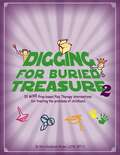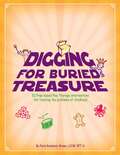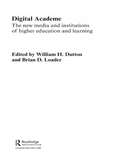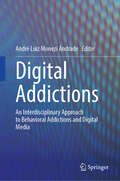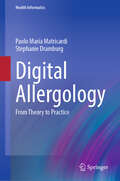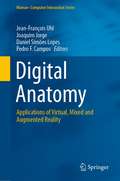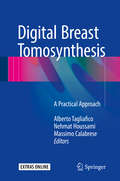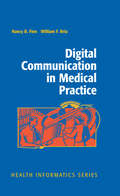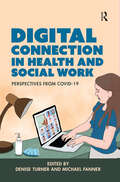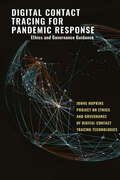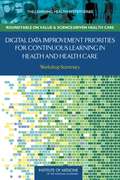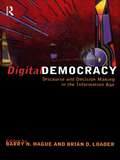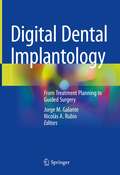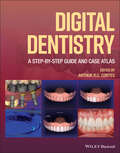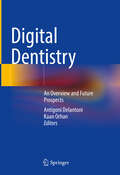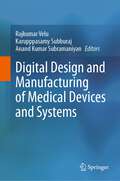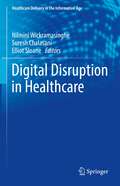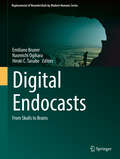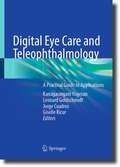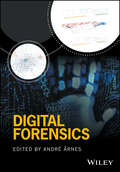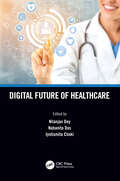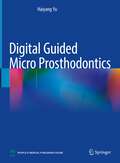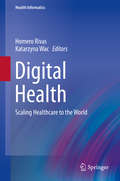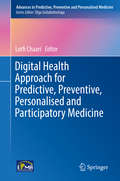- Table View
- List View
Digging for Buried Treasure 2 (52 More Prop-Based Play Therapy Interventions for Treating the Problems of Childhood)
by Paris Goodyear-BrownThis book is brimming with helpful, hands on techniques for engaging children in all kinds of settings. Originally designed to help troubled children to deal with issues related to self-esteem, anger management, social skills and trauma, the techniques have proved to be effective among day care workers, teachers, parents and anyone else looking for ways to playfully strengthen their bonds with children. Each technique comes complete with treatment goals, step-by-step directions, processing questions and much more. This book is a must have for helping professionals and lay people alike.
Digging for Buried Treasure: 52 Prop-Based Play Therapy Interventions for Treating the Problems of Childhood
by Paris Goodyear-BrownThis book is brimming with helpful, hands on techniques for engaging children in all kinds of settings. Originally designed to help troubled children to deal with issues related to self-esteem, anger management, social skills and trauma, the techniques have proved to be effective among day care workers, teachers, parents and anyone else looking for ways to playfully strengthen their bonds with children. Each technique comes complete with treatment goals, step-by-step directions, processing questions and much more. This book is a must have for helping professionals and lay people alike.
Digital Academe: New Media in Higher Education and Learning
by Brian D. Loader William H. DuttonThis book responds to an ever-increasing call from educators, policy makers, journalists, parents and the public at large for analysis that cuts through the hype surrounding the information revolution to address key issues associated with new media in higher education and learning. This collection is of value to those who are seeking a critical, non-commercial exposition of both the enormous opportunities and challenges for higher education that are tied to the use of new information and communication technologies (ICTs) in the development of distance education and distributed learning.The chapters are written by leading exponents, practitioners and researchers from a variety of disciplinary perspectives and the collection as a whole spans national boundaries and reaches beyond the research community to relate to issues of policy and practice.
Digital Addictions: An Interdisciplinary Approach to Behavioral Addictions and Digital Media
by André Luiz Monezi AndradeThis book critically examines digital media's extensive impact on human behavior, psychology, and broader society. It delves into the intricacies of digital addictions, underscoring the imperative for a balanced digital existence today. Through an analysis of the psychological foundations and societal repercussions of internet and smartphone addiction, binge-watching, gaming disorders, and online gambling, the text emerges as a useful resource for navigating the challenges posed by digital technologies. The significance of digital literacy and artificial intelligence's influence on our digital media interactions is thoroughly examined, empowering readers with the tools needed for more adept digital navigation. The book also confronts pressing concerns such as cyberbullying and the necessity for parental guidance in digital media engagement, offering researched strategies to cultivate a safer online milieu. Providing practical advice for individuals, families and educators, this volume aims at closing the gap between digital media engagement and mental health, promoting a more mindful technological usage. It sheds light on the perils of unrestrained digital media interaction while accentuating the opportunities for constructive involvement and the cultivation of essential digital competencies. Digital Addictions: An Interdisciplinary Approach to Behavioral Addictions and Digital Media provides critical insights for a healthier, more enlightened approach to digital media engagement, and will be of interest to psychologists, educators, policymakers, and to a wide range of researchers and practitioners trying to help people find a better balance between digital media consumption and mental health.
Digital Allergology: From Theory to Practice (Health Informatics)
by Paolo Maria Matricardi Stephanie DramburgSeveral hundred million citizens suffer from allergic diseases, ranging from watery eyes to life-threatening anaphylactic shock. In addition to the individual reduction of quality of life, allergies have an impact on workplace efficiency and healthcare budgets. Although new developments of diagnostic assays are advancing quickly, their implementation in clinical routine is challenged by several barriers. This is very evident in the EU, where the gap between technological progress and modern diagnosis is rapidly growing. Digital Health tackles this challenge by providing novel tools, supporting allergy diagnosis and treatment through internet platforms, medical devices, smart-phone apps, telemedicine tools, etc. The integration of Digital Health procedures and tools in the management of allergic diseases will allow personalized diagnostic and therapeutic approaches with 24/7 interactivity between patients and professional healthcare. It will enable the delivery of faster, relevant healthcare support via real-time accessibility of key information for specialists, at primary health care centers, pharmacies and the patient´s home. "Digital Allergology: From Theory to Practice" is unique in comprehensively approaching "Digital Allergology", starting with the general frame to more specific parts on specific allergic diseases, public health as well as research and perspectives from several countries. Allergology being transversal, and covering dozen sub-specialty areas, the list of authors, each one with specific expertise in Digital Health applied to his/her sub-area of interest, is heterogeneous: same sub-areas will be seen from different perspectives. Built for allergists and other clinicians with a strong interest in allergic diseases, it will be a stimulating read for allied health professionals, insurance companies, public health administrators, manufacturers in allergen immunotherapy, IT developers, and clinical scientists.
Digital Anatomy: Applications of Virtual, Mixed and Augmented Reality (Human–Computer Interaction Series)
by Joaquim Jorge Jean-François Uhl Daniel Simões Lopes Pedro F. CamposThis book offers readers fresh insights on applying Extended Reality to Digital Anatomy, a novel emerging discipline. Indeed, the way professors teach anatomy in classrooms is changing rapidly as novel technology-based approaches become ever more accessible. Recent studies show that Virtual (VR), Augmented (AR), and Mixed-Reality (MR) can improve both retention and learning outcomes. Readers will find relevant tutorials about three-dimensional reconstruction techniques to perform virtual dissections. Several chapters serve as practical manuals for students and trainers in anatomy to refresh or develop their Digital Anatomy skills. We developed this book as a support tool for collaborative efforts around Digital Anatomy, especially in distance learning, international and interdisciplinary contexts. We aim to leverage source material in this book to support new Digital Anatomy courses and syllabi in interdepartmental, interdisciplinary collaborations. Digital Anatomy – Applications of Virtual, Mixed and Augmented Reality provides a valuable tool to foster cross-disciplinary dialogues between anatomists, surgeons, radiologists, clinicians, computer scientists, course designers, and industry practitioners. It is the result of a multidisciplinary exercise and will undoubtedly catalyze new specialties and collaborative Master and Doctoral level courses world-wide. In this perspective, the UNESCO Chair in digital anatomy was created at the Paris Descartes University in 2015 (www.anatomieunesco.org). It aims to federate the education of anatomy around university partners from all over the world, wishing to use these new 3D modeling techniques of the human body.
Digital Breast Tomosynthesis
by Alberto Tagliafico Nehmat Houssami Massimo CalabreseThis book provides a comprehensive description of the screening and clinical applications of digital breast tomosynthesis (DBT) and offers straightforward, clear guidance on use of the technique. Informative clinical cases are presented to illustrate how to take advantage of DBT in clinical practice. The importance of DBT as a diagnostic tool for both screening and diagnosis is increasing rapidly. DBT improves upon mammography by depicting breast tissue on a video clip made of cross‐sectional images reconstructed in correspondence with their mammographic planes of acquisition. DBT results in markedly reduced summation of overlapping breast tissue and offers the potential to improve mammographic breast cancer surveillance and diagnosis. This book will be an excellent practical teaching guide for beginners and a useful reference for more experienced radiologists.
Digital Communication in Medical Practice
by William F. Bria Nancy B. FinnIntroducing Digital Communications into Your Medical Practice discusses how electronic medical records and personal health records now digitize patient information and make it accessible for review and easy to update by both doctors and patients. The text emphasizes on how the use of email and the internet will help patients to schedule appointments, access test results and research healthcare options. In addition, topics discussed include stories on how simple everyday telemedicine tools, such as telephones with cameras attached, enable doctors and nurses to carry on conversations with patients who are homebound and need daily monitoring. The text addresses the legislative initiatives that will protect physician and patients from the unauthorized access to medical records as well as discussing how e-prescribing doctor/pharmacist teams and automated databases help patients manage their medications more effectively. Case studies are also provided to illustrate real life situations showing how this technology is deployed and why it is so critical to healthcare.
Digital Connection in Health and Social Work: Perspectives from Covid-19
by Denise Turner Michael FannerThis book focusses on the move to digitally mediated forms of teaching, learning and practice during Covid-19 and offers a series of case studies which showcase positive practices during this time.Education, Health and Social Work services have all been at the forefront of national debate since the first UK lockdown in March 2020. Schools, Colleges and Higher Education institutions moved rapidly to online delivery, with educators, parents, practice learning partners and students alike compelled to adapt to online connection, disrupting previous norms and forcing a rapid acquisition of new skills.In health and social care practice, there has been a similar move to online delivery, whilst maintaining consistency of service and support. The pandemic also coincided with the recommendations of the national Digital Capabilities for Social Work project, commissioned by Health Education England, which produced a prescient framework for professional practice.This book showcases innovative ways in which practice and education have responded to the challenges of Covid 19. With ongoing debate about planning for the next pandemic, as well as adapting to the post Covid landscape, the book is a valuable resource for all those involved in health and social work education and practice.
Digital Contact Tracing for Pandemic Response: Ethics and Governance Guidance
by Jeffrey Kahn; Johns Hopkins Project on Ethics and Governance of Digital Contact Tracing TechnologiesAs nations race to hone contact-tracing efforts, the world's experts consider strategies for maximum transparency and impact.As public health professionals around the world work tirelessly to respond to the COVID-19 pandemic, it is clear that traditional methods of contact tracing need to be augmented in order to help address a public health crisis of unprecedented scope. Innovators worldwide are racing to develop and implement novel public-facing technology solutions, including digital contact tracing technology. These technological products may aid public health surveillance and containment strategies for this pandemic and become part of the larger toolbox for future infectious outbreak prevention and control. As technology evolves in an effort to meet our current moment, Johns Hopkins Project on Ethics and Governance of Digital Contact Tracing Technologies—a rapid research and expert consensus group effort led by Dr. Jeffrey P. Kahn of the Johns Hopkins Berman Institute of Bioethics in collaboration with the university's Center for Health Security—carried out an in-depth analysis of the technology and the issues it raises. Drawing on this analysis, they produced a report that includes detailed recommendations for technology companies, policymakers, institutions, employers, and the public. The project brings together perspectives from bioethics, health security, public health, technology development, engineering, public policy, and law to wrestle with the complex interactions of the many facets of the technology and its applications.This team of experts from Johns Hopkins University and other world-renowned institutions has crafted clear and detailed guidelines to help manage the creation, implementation, and application of digital contact tracing. Digital Contact Tracing for Pandemic Response is the essential resource for this fast-moving crisis.Contributors: Joseph Ali, JD; Anne Barnhill, PhD; Anita Cicero, JD; Katelyn Esmonde, PhD; Amelia Hood, MA; Brian Hutler, Phd, JD; Jeffrey P. Kahn, PhD, MPH; Alan Regenberg, MBE; Crystal Watson, DrPH, MPH; Matthew Watson; Robert Califf, MD, MACC; Ruth Faden, PhD, MPH; Divya Hosangadi, MSPH; Nancy Kass, ScD; Alain Labrique, PhD, MHS, MS; Deven McGraw, JD, MPH, LLM; Michelle Mello, JD, PhD; Michael Parker, BEd (Hons), MA, PhD; Stephen Ruckman, JD, MSc, MAR; Lainie Rutkow, JD, MPH, PhD; Josh Sharfstein, MD; Jeremy Sugarman, MD, MPH, MA; Eric Toner, MD; Mar Trotochaud, MSPH; Effy Vayena, PhD; Tal Zarsky, JSD, LLM, LLB
Digital Data Improvement Priorities for Continuous Learning in Health and Health Care
by Institute of MedicineDigital health data are the lifeblood of a continuous learning health system. A steady flow of reliable data is necessary to coordinate and monitor patient care, analyze and improve systems of care, conduct research to develop new products and approaches, assess the effectiveness of medical interventions, and advance population health. The totality of available health data is a crucial resource that should be considered an invaluable public asset in the pursuit of better care, improved health, and lower health care costs. The ability to collect, share, and use digital health data is rapidly evolving. Increasing adoption of electronic health records (EHRs) is being driven by the implementation of the Health Information Technology for Economic and Clinical Health (HITECH) Act, which pays hospitals and individuals incentives if they can demonstrate that they use basic EHRs in 2011. Only a third had access to the basic features necessary to leverage this information for improvement, such as the ability to view laboratory results, maintain problem lists, or manage prescription ordering. In addition to increased data collection, more organizations are sharing digital health data. Data collected to meet federal reporting requirements or for administrative purposes are becoming more accessible. Efforts such as Health. Data. gov provide access to government datasets for the development of insights and software applications with the goal of improving health. Within the private sector, at least one pharmaceutical company is actively exploring release of some of its clinical trial data for research by others. Digital Data Improvement Priorities for Continuous Learning in Health and Health Care: Workshop Summary summarizes discussions at the March 2012 Institute of Medicine (2012) workshop to identify and characterize the current deficiencies in the reliability, availability, and usability of digital health data and consider strategies, priorities, and responsibilities to address such deficiencies.
Digital Democracy: Discourse and Decision Making in the Information Age
by Brian D. Loader Barry N. HagueDigital Democracy considers how technological developments might combine with underlying social, economic and political conditions to produce new vehicles for democratic practice.The growth of new Information and Communication Technologies (ICTs) such as the Internet, alongside growing concerns about the failure of advanced societies to live up to the democratic idea, has produced much interest in the prospects for a digital democracy.This book will provide invaluable reading for those studying social policy, politics and sociology as well as for policy analysts, social scientists and computer scientists.
Digital Dental Implantology: From Treatment Planning to Guided Surgery
by Jorge M. Galante Nicolás A. RubioThis book describes the fusion of CBCT and CAD/CAM technologies for the purpose of surgical dental treatments and explains the advantages and applications of this digital approach for implant placement procedures and other oral surgical protocols. All aspects of computer-aided imaging and design are first covered in the textbook, including the creation of DICOM and STL files; followed by the process of virtual merging to obtain a combined image. Secondly, clinical tips for the use of digital wax up, software interactions and accurate template fabrication are explained, including subtractive and additive methods used for this manufacturing step.The remainder of the book is devoted to the application of technology fusion in implantology, guided bone regeneration, and maxillofacial surgery. Both static and dynamic guided surgeries are described. Materials characteristics and surgical instruments are also presented to define a correct selection criteria. The digital approach outlined in this textbook involves a paradigm shift in the way traditional oral surgery is conceived. Technology fusion aims to improve treatment accuracy, optimize clinical time and reduce patient morbidity. Clinicians will find this book to be a valuable guide for virtual surgical planning and a path to introduce themselves into the exciting world of digital dental surgery.
Digital Dentistry: A Step-by-Step Guide and Case Atlas
by Arthur R.G. CortesAn indispensable introduction to using digital technology in dentistry Digital Dentistry: A Step-by-Step Guide and Case Atlas provides basic information on the use of digital resources to find a diagnosis, create a treatment plan, and execute that strategy within different dental specialisms. This manual includes the science behind all procedures that use digital technology and provides a clinical step-by-step guide toward the use of these developments for every dental specialty area. Users will find a wide range of areas covered, from prosthodontics, restorative dentistry, and endodontics to oral and maxillofacial surgery and public health. This book also includes: A guide to all current basic digital imaging and CAD-CAM procedures, with an emphasis on the most popular systems and software programs. An atlas of multidisciplinary cases that were treated with digital dentistry, from diagnosis and treatment planning to execution and follow-up, in order of complexity Assessment of the scientific basis for using digital dentistry in each category A presentation of clinical cases to support the use of digital methodologies in all relevant scenarios An exploration of the role of digital dentistry in dental public health, preventive dentistry, and dental education Ideal for dental clinicians—general practitioners and specialists—as well as all other dental professionals, such as dental technologists, dental hygienists, and dental students, Digital Dentistry: A Step-by-Step Guide and Case Atlas is an essential tool and reference work to help dental practitioners streamline and update their practice with the most up-to-date technologies.
Digital Dentistry: An Overview and Future Prospects
by Kaan Orhan Antigoni DelantoniThis book focuses on recent technological advances in digital dentistry. It provides information on digital aspects in all dental fields including digital caries detection systems, digital color matching, and digital applications in periodontology, surgical implant placement, oral histopathology and pediatric dentistry. Training in emerging and new digital techniques is inevitable in the dental profession. This book contains detailed digital procedures, their basics and their applications. It is divided into three parts: Basic Digital Systems in Dentistry, Novelties and Advances in Digital Dentistry, The Future of Digital Dentistry and Applications. Readers will learn about Artificial Intelligence in dentistry, tissue engineering applications and dental education tools in digital dentistry. The book is a must have for all dental practitioners who would like to deepen their knowledge and understanding of digital systems in dentistry.
Digital Design and Manufacturing of Medical Devices and Systems
by Karupppasamy Subburaj Rajkumar Velu Anand Kumar SubramaniyanThis book coherently presents the advances in technological principles, processes, and methods of Additive Manufacturing (AM), Augmented reality (AR), and Internet of things (IoT) in biomedical technology. It offers an overview of these high-impact technologies in terms of materials, processes, and in-situ monitoring of fabricating biomedical devices, implants, and prosthetics. Furthermore, the book also aimed to cover pedagogical applications, including the design and development of high-fidelity anatomical and hybrid physiological human models, for medical and design students and clinicians for learning, understanding, and gaining insights into the structures and functions of human organs and pathology. In turn, the book also discusses the applications of artificial intelligence in the 3-D printing of pharmaceuticals. This book is a useful resource for manufacturers, scientists, engineers, and young research scholars understand disruptive technology's real potential in biomedicalapplications.
Digital Disruption in Health Care (Healthcare Delivery in the Information Age)
by Nilmini Wickramasinghe Suresh Chalasani Elliot SloaneDigital disruption in healthcare is generating new technologies, applications, and large data sets, and these are all precipitating significant changes in healthcare processes. Emerging applications due to digital disruption and their impact on healthcare delivery and quality are becoming some of the key focus areas of research. However, to date, systematic, generalizable, full-scale evaluation of these new technologies/applications is lacking. Little is known about the net short- or long-term health and wellness impacts of digital technologies. Similarly, the care-delivery and management process changes caused by digital disruption are forcing healthcare organizations to react rather than plan for them in advance. Given these gaps, this book addresses the technology, applications, data, and process aspects of digital disruption in healthcare. This volume is a collection of key areas in health and wellness impacted by digital disruption. It highlights the benefits, barriers, facilitators, and transformative forces that are shaping healthcare digital disruption. Topics explored in the chapters include: Towards Network Medicine: Implementation of Panomics and Artificial Intelligence for Precision MedicineTelehealth Implementation: A Synopsis of Patients’ Experience of Clinical OutcomesRealising the Healthcare Value Proposition of Better Access, Quality and Value of Care by Incorporating the Social Determinants of Health with Digital HealthThe Internet Hospital in the Time of COVID-19: An Example from China Given the diverse interest in healthcare delivery solutions today, the need is broad across academia and the healthcare industry for a comprehensive resource for teaching, practice, and research. Digital Disruption in Healthcare is a point-of-entry resource for transferring theory into practice for heads of IT departments in hospitals, consultants, and academia, as well as scholars and researchers. Both graduate and undergraduate students as well as certificate-seeking health informatics and public health students would benefit from this book. Furthermore, it is useful for healthcare stakeholders including healthcare professionals, clinicians, medical administrators, managers, consultants, policy-makers, and IT practitioners within the healthcare space.
Digital Endocasts
by Emiliano Bruner Naomichi Ogihara Hiroki C. TanabeThis book is dedicated to a specific component of paleoneurology, probably the most essential one: endocasts. A series of original papers collected here focuses on describing methods and techniques that are dedicated to reconstruct and study fossil endocasts through computed tools. The book is particularly oriented toward hominid paleoneurology, although it also includes chapters on different taxa to provide a more general view of current perspectives and problems in evolutionary neuroanatomy. The first part of the book concerns techniques and tools to cast endocranial anatomy. The second part deals with computed morphometrics, and the third part is devoted to comparative neurobiology. Those who want to approach the field in general terms will find this book especially helpful, as will those researchers working with endocranial anatomy and brain evolution. The book will also be useful for researchers and graduate students in anthropology, bioarchaeology, medicine, and related fields.
Digital Eye Care and Teleophthalmology: A Practical Guide to Applications
by Kanagasingam Yogesan Leonard Goldschmidt Jorge Cuadros Giselle RicurThis book describes digital ophthalmology and telemedicine applications for both front of the eye and retina. It includes technical issues, digital imaging, what clinical parameters to use, which technologies are suitable, and collective experiences of practitioners in different parts of the world practicing a wide range of digital eye care delivery. The main purpose of this book is to provide adequate information to clinicians and other health professionals who are involved in eye care delivery to assess how digital health in ophthalmology might be applied to their working practice, how digital screenings are performed, and to learn about virtual image reading. Many of the chapters are also helpful to health service managers, imaging specialists, and information technology staff. Digital Eye Care and Teleophthalmology: A Practical Guide to Applications examines digital eye care to provide state of art ophthalmic services. It is an essential resource for professionals involved in eye care seeking to develop or improve their digital applications in daily practice.
Digital Forensics
by André ÅrnesThe definitive text for students of digital forensics, as well as professionals looking to deepen their understanding of an increasingly critical field Written by faculty members and associates of the world-renowned Norwegian Information Security Laboratory (NisLab) at the Norwegian University of Science and Technology (NTNU), this textbook takes a scientific approach to digital forensics ideally suited for university courses in digital forensics and information security. Each chapter was written by an accomplished expert in his or her field, many of them with extensive experience in law enforcement and industry. The author team comprises experts in digital forensics, cybercrime law, information security and related areas. Digital forensics is a key competency in meeting the growing risks of cybercrime, as well as for criminal investigation generally. Considering the astonishing pace at which new information technology – and new ways of exploiting information technology – is brought on line, researchers and practitioners regularly face new technical challenges, forcing them to continuously upgrade their investigatory skills. Designed to prepare the next generation to rise to those challenges, the material contained in Digital Forensics has been tested and refined by use in both graduate and undergraduate programs and subjected to formal evaluations for more than ten years. Encompasses all aspects of the field, including methodological, scientific, technical and legal matters Based on the latest research, it provides novel insights for students, including an informed look at the future of digital forensics Includes test questions from actual exam sets, multiple choice questions suitable for online use and numerous visuals, illustrations and case example images Features real-word examples and scenarios, including court cases and technical problems, as well as a rich library of academic references and references to online media Digital Forensics is an excellent introductory text for programs in computer science and computer engineering and for master degree programs in military and police education. It is also a valuable reference for legal practitioners, police officers, investigators, and forensic practitioners seeking to gain a deeper understanding of digital forensics and cybercrime.
Digital Future of Healthcare
by Nilanjan DeyThis book focuses on the applications of different digital platforms in the field of healthcare. It describes different devices used in digital healthcare, their benefits, diagnosis, use in treatment, and use cases related to mobile healthcare. Further, it covers machine and deep learning, blockchain technology, big data analytics as relevant to digital healthcare, telehealth technology, and digital applications in the field of push-and-pull pharma marketing. Overall, it enables readers to understand the basics of decision-making processes using digital techniques for the healthcare field. Features: Discusses various aspects of digitization of healthcare systems Examines deployment of machine learning including IoT and medical analytics Provides studies on the design, implementation, development, and management of intelligent healthcare systems Includes sensor-based digitization of healthcare data Reviews real-time advancement and challenges of digital communication in the field of healthcare This book is aimed at researchers and graduate students in healthcare, internet of things, machine learning, computer science, robotics, wearables, electrical engineering, and biomedical engineering.
Digital Guided Micro Prosthodontics
by Haiyang YuThis book focuses on the clear and simplified clinical techniques for microscopic restoration dentistry. With the help of microscope and hole reference technique (HRT), dentists can design the dimensional relationship and carry it out in preparation precisely. Authors firstly introduce an overview and surgical microscope and auxiliary instruments. In the second part, there are 4 techniques shown in each chapter.
Digital Healing: People, Information, Healthcare
by Marc RingelMedical practice and research are inconceivable today without electronic computing and communication tools. Digital machines do many tasks orders-of-magnitude better, faster and more accurately than humans.Still, there are functions critical to the healthcare endeavor that people do much better than machines, things like: understanding and using natural language; perceiving what is unexpressed; taking into account values, culture, ethics, and human relationships; touching and healing. For the foreseeable future, the "smartest" computers will be no match for human beings when it comes to performing these most anthropic functions.American healthcare is at a critical juncture. Providers and patients are increasingly frustrated by degradation of the human relationships that lie at the core of the medical practice. Technologies, such as the computerized medical record, get much of the blame for intrusion into the patient-provider relationship. However, it is not technology itself that is to blame. The fault lies with how systems are conceived, designed, and deployed.This book analyzes how to organize the work of healthcare in a way that uses machines to do what they do best, thereby freeing humans to do what we do best. Smart use of electronic technology is crucial to the success of any bid to fulfill the Institute for Healthcare Improvement’s triple aim to make healthcare more effective, efficient, and humane.
Digital Health
by Homero Rivas Katarzyna WacThis book presents a comprehensive state-of the-art approach to digital health technologies and practices within the broad confines of healthcare practices. It provides a canvas to discuss emerging digital health solutions, propelled by the ubiquitous availability of miniaturized, personalized devices and affordable, easy to use wearable sensors, and innovative technologies like 3D printing, virtual and augmented reality and driverless robots and vehicles including drones. One of the most significant promises the digital health solutions hold is to keep us healthier for longer, even with limited resources, while truly scaling the delivery of healthcare. Digital Health: Scaling Healthcare to the World addresses the emerging trends and enabling technologies contributing to technological advances in healthcare practice in the 21st Century. These areas include generic topics such as mobile health and telemedicine, as well as specific concepts such as social media for h ealth, wearables and quantified-self trends. Also covered are the psychological models leveraged in design of solutions to persuade us to follow some recommended actions, then the design and educational facets of the proposed innovations, as well as ethics, privacy, security, and liability aspects influencing its acceptance. Furthermore, sections on economic aspects of the proposed innovations are included, analyzing the potential business models and entrepreneurship opportunities in the domain.
Digital Health Approach for Predictive, Preventive, Personalised and Participatory Medicine (Advances in Predictive, Preventive and Personalised Medicine #10)
by Lotfi ChaariThis collection, entitled Digital Health for Predictive, Preventive, Personalized and Participatory Medicine contains the proceedings of the first International conference on digital healthtechnologies (ICDHT 2018). Ten recent contributions in the fields of Artificial Intelligence (AI) and machine learning, Internet of Things (IoT) and data analysis, all applied to digital health. This collection enables researchers to learn about recent advances in the above mentioned fields. It brings a technological viewpoint of P4 medicine. Readers will discover how advanced Information Technology (IT) tools can be used for healthcare. For instance, the use of connected objects to monitor physiological parameters is discussed. Moreover, even if compressed sensing is nowadays a common acquisition technique, its use for IoT is presented in this collection through one of the pioneer works in the field.In addition, the use of AI for epileptic seizure detection is also discussed as being one of the major concerns of predictive medicine both in industrialized and low-income countries.This work is edited by Prof. Lotfi Chaari, professor at the University of Sfax, and previously at the University of Toulouse. This work comes after more than ten years of expertise in the biomedical signal and image processing field.
